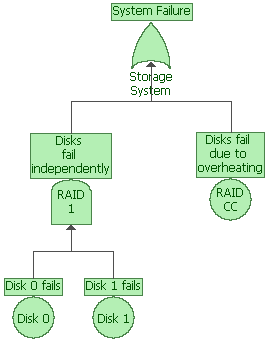The Beta Factor Method
Common Cause Failures (CCFs) are single faults that result in the failure of multiple components. Typical examples include impact, vibration, temperature, contaminants, miscalibration, improper maintenance, etc. There are different methods to address CCFs, both qualitative and quantitative. In this article, we discuss the β factor method and provide an example of an application of this method using BlockSim 7.
The β factor method is an approximation method used for the quantitative evaluation of CCFs. In this method, the likelihood of the CCF is evaluated in relation to the random failure rate for the component. A β factor is estimated such that β% of the failure rate is attributed to the CCF and (1- β)% to the random failure rate of the component. Ideally, this factor is obtained through historical data by determining the percentage of all the component failures in which multiple similar components failed. In the absence of this information, it may also be obtained qualitatively (refer to [1] for a partial list of sources on this subject).
In the following example, a redundant array of independent disks (RAID) is modeled. In this system, the data is written identically to two disks, thus providing redundancy. However, failures due to overheating have been identified due to the location where the system operates. Analyzing the available historical data provides an estimate of the β factor where β is found to be 0.08. In other words, 8 out of 100 disk failures can be attributed to overheating that resulted in the failure of both disks. In addition, the failure rate of each disk (including all failures) is 0.017 failures per year.

The first step is to adjust the disk failures by a factor of (1- β); that is, the failure rates for the events Disk 0 fails and Disk 1 fails need to be multiplied by (1- β). To model this in BlockSim 7, a factor called the duty cycle is used. Some common applications for the duty cycle involve components that do not operate continuously or experience changes in environmental stress. For example, consider a CD-ROM drive in a computer that accumulates only 10 minutes of operating time for every 60 minutes the computer operates. The duty cycle in this case would be 0.167. (For more information on the duty cycle refer to [2].)
If t' = dc x t (where dc is the duty cycle), then:
![]()
In the case of an exponential model, we also have:
![]()
The failure rate of the disks can then be adjusted by (1-β) in BlockSim 7 by setting the following values in the General and Reliability tabs of the Block Properties window:


The next step is to similarly model the common cause event (the RAID CC block) by setting the failure rate of the disk to 0.017 and the duty cycle value to 0.08.
We can obtain the probability of occurrence of a system failure at any time by using the Quick Calculation Pad. For example, the probability of failure after one year is 0.0016, as shown below.

Note that if the common cause failure had been ignored (that is, if only the two disks in redundancy had been taken into account), the probability of the failure of the system would have been calculated as 0.0003, largely underestimating the probability of failure.
Conclusions
This article briefly illustrated how the β factor method can be applied for common cause failure analysis in BlockSim 7. Although failure rates can be manually adjusted to implement this method, inputting the β factor separately as the duty cycle allows for easy access and modification.
References
[1] Summers, Angela E., Kimberly A. Ford, and Glenn Raney, "Estimation and Evaluation of Common Cause Failures in SIS." Presented at the 1999 Loss Prevention Symposium, Houston, Texas, March 1999. http://www.iceweb.com.au/sis/e_and_e.htm.
[2] ReliaSoft Corporation, Life Data Analysis Reference, Tucson, AZ: ReliaSoft Publishing, 2007.